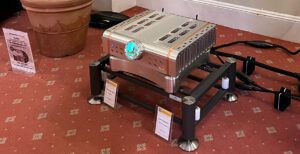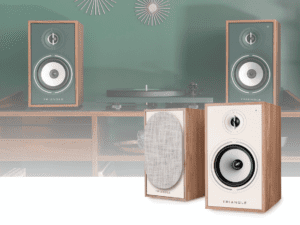
In 2009, Linn Products made headlines both in and outside of the audiophile world, by ceasing production of CD players. “CD Player maker stops making CD players” is a newsworthy story when the mass media want to show how CD sales are slipping. I don’t think the company will get the same traction with today’s news, but Linn has just announced that it is to drop all of its analogue preamplifiers.
Linn is so convinced by its DSM players (the latest versions of the DS components that saw off its CD players six years ago) that it is to discontinue its Klimax and Akurate preamplifiers, leaving only the Majik integrated. It will continue its DS players as standalone source components for those who still use more conventional audio systems, but Linn is basing its future on systems that use the source component as a combination source/controller. This also works with Linn’s DSP-oriented Space Optimisation system to better integrate loudspeakers with the room. More on that later.
In some respects, Linn is only following Meridian Audio’s lead here, as the Cambridge-based audio technology company has championed digital active loudspeaker systems that eschewed analogue line outputs since the 1990s. However, even Meridian has retained analogue preamp outputs on its flagship 818v2 Reference Audio Core; even if they are vestigial in design, it’s still a bold move on Linn’s behalf to drop the analogue preamplifier altogether.
Linn’s move is perhaps doubly bold, because the company is still thought of in terms of its analogue replay chain, thanks to the evergreen Sondek LP12. Of course, further investigation shows there’s notionally no problem here, as the DSM products Linn thinks will be the future of audio replay and control include analogue inputs for a phono stage. However, this phono stage will be almost immediately passed through an A/D converter, which will upset some vinyl die-hards on principle.
Perhaps more interesting than Linn deep sixing the analogue preamplifier, is the reasons why the company feels it is able to make so bold a move. Where a few years ago, an audiophile might legitimately have a turntable, CD player, tuner, a recorder of some description, and possibly even a couple of TV-related sources at line level running through a preamplifier, many of these sources have now migrated to computer or file-based systems. Linn’s Digital Stream system now encompasses music stored locally on NAS drives in the home network, online streamed music from Tidal, Qobuz, and other providers, internet radio through Jamcast and any computer audio files through Songcast. Also, TV audio signals are now routed through HDMI instead of line level as a matter of course now. That just leaves LP and tape recording, and few people are recording these days!
In a way, Linn’s move to get rid of the preamplifier is a logical extension of the way audio systems are moving. If most of our audio is coming to us through a single computer-based digital source, do we need the additional links in the audio chain that make up a preamplifier? This question has been asked several times in the past (most notably by Wadia and dCS), but as they principally relied on CD as source component, these digital hubs weren’t really ‘hubby’ enough. Now, with either an UPnP network or a computer taking on a more multi-format front-end role, the preamp-free system could be an idea whose time has finally come. Interestingly, a lot of the buzz at Munich around some of the ‘must have’ DACs (like the Exogal Comet, Chord’s DAVE, Moon’s 780D, and more) all followed along similar lines.
For more traditional audio enthusiasts, the chances of them turning in their preamplifiers are slim. Many still use a multitude of line-level sources, and many will still prefer the sound of the gain structure of a good preamplifier over a direct digital connection. These arguments were sound ones when the preamp’s place in audio was first called to account. They are just as sound today. But I also can’t help feeling each successive year, more and more people will be won over by the direct digital approach. Whether that approach is Linn’s approach remains to be seen.
Linn makes a cogent argument for a predominantly digital approach thanks to its Space Optimisation system. Beginning with Linn’s own active loudspeakers, but now rapidly adding new loudspeakers (mostly from UK-based brands like Bowers & Wilkins, PMC, and Spendor) this allows the user or the installer to enter basic parameters of room size, construction, furnishing, and the position of both listener and speakers into a program that will in essence compensate for the iniquities of the real world. It also allows loudspeakers to be positioned in less-than-ideal spaces to accommodate domestic concerns.

To accompany an upcoming review of the Linn Majik Sondek LP12, Linn also provided a Linn Majik DSM integrated amp/streamer that includes Space Optimisation DSP, and I have a pair of Spendor D1 two-way sealed box standmounts in for an upcoming review (which also happen to be on the Space Optimisation list). We entered the real-world listening parameters in at source, and then took the option to turn the Space Optimisation ‘on’ and ‘off’ and reposition the loudspeakers in a worst-case setting to see how good the system was at compensating.
This will be the subject of upcoming reviews, but Space Optimisation does (mostly) work and (mostly) work extremely well. Audiophiles are often short on pragmatism, so the idea of moving the loudspeakers away from their optimum position just to keep the family happy is against audiophile nature, but many are not able to be so uncompromising, and if it’s a choice between poor speaker positioning and a divorce court, poor positioning wins out… probably. In which case, the difference between using the loudspeakers with all the room boom that comes from being placed against the wall significantly overcomes that slight sense of DSP getting in the way of the mix. When used in the optimum position, the difference in treating the room is fairly significant, too, although this depends on the quality of room.
In some respects, Space Optimisation is more noticeable the more ‘acoustic’ the music playing (and the more used to acoustic music you are), but the worse the room, the better the result, and that should win many over. Note that this doesn’t use a measurement microphone, and one simply enters the physical parameters of the room in terms of dimensions, physical properties, and so on.
I don’t want Space Optimisation to distract too far from what Linn has done here, though. The signal processing is an inherent part of Linn’s DSM system and would not be applicable in analogue preamplification (because it is deployed through the digital signal path more or less up to the crossover in the speakers). The more important thing is the removal of the preamplifier from the signal path.
There will always be those who see ill in this move. When Linn dropped the CD, the move was said to be down to Linn being unable to make a good player, it not having the right contracts with the right parts suppliers, and the company pulling a stunt for the media. This will be seen as Linn not being able to make a good amplifier or discontinuing unpopular lines by the nay-sayers. I think it presages much, but maybe not as much as Linn might like to think – the CD world didn’t grind to a halt when Linn walked away from the market and, although sales continue to shrinking, there is still market for players. I suspect that we will still see the preamplifier as system nexus for many years to come, even though I also think more and more people will go down the preamp-less digital route over time. Hopefully, that some will and some won’t be using a preamp in future doesn’t trigger the audiophile equivalent of World War III!
Tags: FEATURED
By Alan Sircom
More articles from this authorRead Next From Blog
See all
Audio Show Deluxe 2024: A photo show report
- Mar 28, 2024

Paul Messenger 1949-2024: A personal tribute
- Mar 26, 2024

Bristol Hi-Fi Show 2024: See You There!
- Feb 21, 2024

Triangle Borea Connect
- Feb 19, 2024










